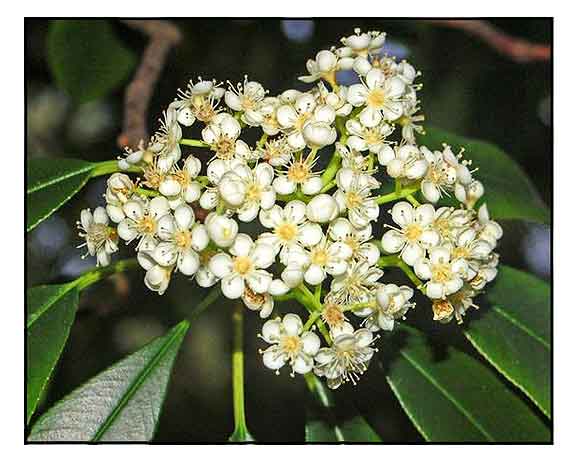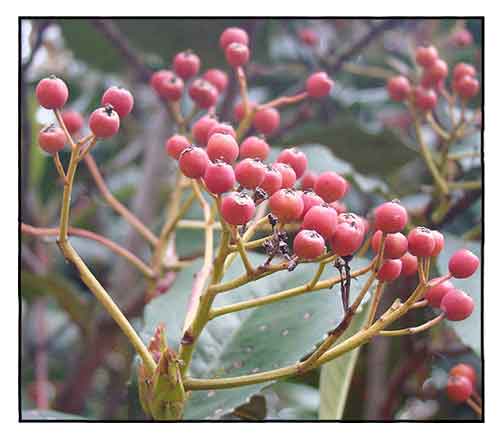
Family • Rosaceae
Sugsuggat
Photinia serratifolia (Desf.) Kalkman
CHINESE PHOTINIA
Shi nan
| Scientific names | Common names |
| Crataegus serratifolia Desf. | Sugsuggat (Igorot) |
| Photinia serratifolia (Desf.) Kalkman | Chinese hawthorn (Engl.) |
| Pyrus serratifolia (Desf.) M.F.Fay & Christenh. | Chinese photinia (Engl.) |
| Accepted infraspecifics | Oriental photinia (Engl.) |
| Photinia serratifolia var. ardisiifolia (Hayata) H.Ohashi | Taiwanese photinia (Engl.) |
| Photinia serratifolia var. daphniphylloides (Hayata) L.T.Lu | |
| Photinia serratifolia var. lasiopetala (Hayata) L.Ohashi | |
| Photinia serratifolia var.serratifolia | |
| Photinia serratifolia is an accepted species. KEW: Plants of the World Online | |
| Note: Many articles list Photinia serrulata as a synonym of Photinia serratifolia. Plants of the World Online lists Photinia serrulata Lindl. as a synonym of Photinia glabra, and Photinia serrulata f. ardisiifolia (Hayata) H.L.Li as a synonym of Photinia serratifolia var. ardisiifolia. | |
| Other vernacular names |
| CHINESE: Shi nan. |
Distribution
Properties Studies Availability |
February 2023
![]()
 |
| PHOTOS / ILLUSTRATIONS |
| IMAGE SOURCE: Photograph: Photinia serratifolia - flower and leaf detail / © Ettore Balocchi / CC by 2.0 / non-commercial use / click on image to go to source page / North Carolina EXTENSION GARDENER Plant Toolbox |
| OTHER IMAGE SOURCE: Photograph: Photinia serratifolia - leaves and flowers / © KENPEI / CC BY-SA 3.0 / non-commercial use / click on image to go to source page / North Carolina EXTENSION GARDENER Plant Toolbox |
| OTHER IMAGE SOURCE: Photograph: Photinia serratifolia - leaves and flowers / © Rebekah D Wallace / University of Georgia, Bugwood Org / CC BY-NC 3.0 / non-commercial use / click on image to go to source page / Forestry Images |
Additional
Sources and Suggested Readings |
• |
DOI: It is not uncommon for links on studies/sources to change. Copying and pasting the information on the search window or using the DOI (if available) will often redirect to the new link page. (Citing and Using a (DOI) Digital Object Identifier) |
| List of Understudied Philippine Medicinal Plants |
• |
 |




